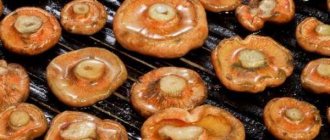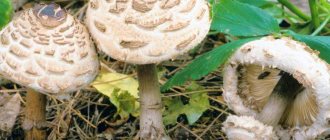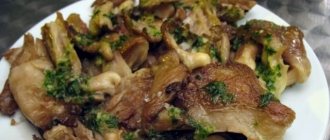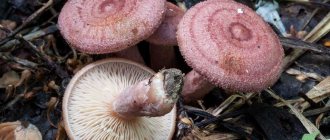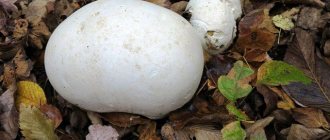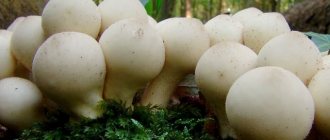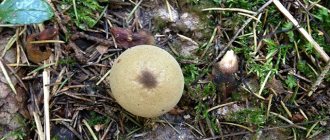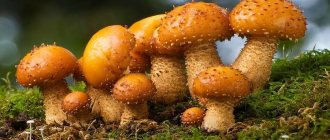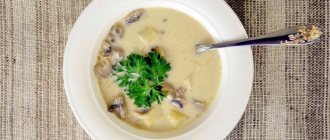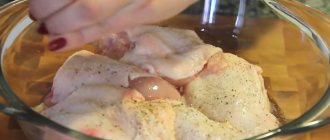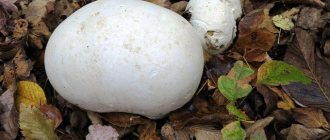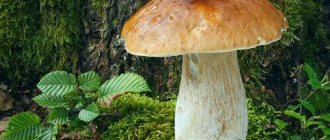How to cook puffball mushroom - interesting ideas for preparing delicious dishes
Even experienced foresters are interested in how to prepare puffball mushroom in order to serve not only an edible, but also a tasty dish. The answer is simple: a relative of the champignon is endowed with juicy, creamy snow-white pulp, which is not very suitable for cooking, but is incredibly good in batter, breadcrumbs, stewed in cream or fried with onions in a frying pan.
What does a puffball mushroom look like?
The external properties of the puffball mushroom are very attractive: it looks like a huge ball, has dense, juicy pulp, which, depending on the subspecies, can grow to a weight of about 10 kg. Since you can find raincoats everywhere: in parks, gardens, meadows and along roadways, a few useful tips will help in choosing mushrooms.
- Only young mushrooms should be collected. They have an attractive white color, dense and strong flesh. Only such mushrooms are edible, tasty and healthy.
- Old and inedible mushrooms have yellow flesh and a light brown shell.
- A raincoat tends to absorb moisture, so you should not pick mushrooms immediately after rain - there is a chance you will end up with a jelly-like mass.
Edible species
There are more than 50 types of raincoats. Among them there are edible, conditionally edible (suitable for consumption only after careful heat treatment) and inedible (they do not contain poison, but they are poorly absorbed by the human body or are unpleasant to the taste).
The most common edible species are pear-shaped, black-spined, yellow-colored, ragged, and spiny.
Pear-shaped puffball (Lycoperdon pyriforme)
On the soil it looks like a ball, since the pseudopod is short and often does not show on the surface. The fruit body has a diameter of 3-7 cm, the height of the entire mushroom is no more than 4 cm.
The young puffball has white skin and cotton-like flesh. As they mature, the skin and “filling” darken, becoming red or brown. Upon contact with an adult puffball, the surface cracks like an eggshell, releasing brown spores. Only young mushrooms with light flesh when cut are suitable for food.
It grows in large crowded groups in moist deciduous and coniferous forests of any country. It is found everywhere in Russia. Most often, flutter can be found on rotting wood (for example, on rotten stumps).
Black-thorned puffball (Lycoperdon echinatum)
People also call this raincoat spiky or hedgehog. It has a pear shape. A characteristic feature is the spines pressed closely together, covering the entire surface of the mushroom. These needles are not sharp and easily fall off with a touch to the puffball, exposing the smooth skin. Young mushrooms have white flesh; in adults it turns green or brown. A cavity with dark spores forms in the center of the old puffball.
This mushroom grows singly or in small scattered groups. Mainly found in heather heaths and deciduous forests.
It can also be found on calcareous soils. In Russia, it is most widespread in the European part, in the forests located along the Volga, Dnieper and Don.
Yellow-colored puffball (Lycoperdon flavotinctum)
A round mushroom with a large fruiting body and a stalk less than 1 cm in length. The surface is beige or yellow (the younger the mushroom, the brighter it is), rough. When the spores mature, the outer shell cracks like an egg peel, revealing a circular cavity filled with dark dust from the spores.
When cut, young porcini mushrooms have clear longitudinal fibers - only such specimens are suitable for cooking. With age, the mushroom darkens from the inside and becomes rancid in taste.
It does not bear fruit every year. Distributed in Eastern Europe and North America. For Russia, a yellow-colored raincoat is a rarity. Infrequently, mushroom pickers find it in the deciduous forests of Moscow, Rostov, Kaluga and other regions of the European part of the country.
Puffball (Lycoperdon velatum)
The mushroom is 3 to 6 cm high. It has a clearly defined short stalk and a wide upper part. The surface is uneven, as if torn, which is why it got the name “ragged”.
The color of the shell can be white in young specimens, but with age it becomes reddish-brown. The pulp also gradually darkens - from milky to chocolate.
Only light cut mushrooms are suitable for food.
Grows in small groups in oak and oak-hornbeam forests. Found in Belarus, Ukraine, Europe, Southeast Asia and North America. In Russia, the largest populations are in the Central and Central Black Earth parts, as well as in the North Caucasus region.
Meadow puffball (Vascellum pretense)
It has a rounded fruit body, tapering downward. Diameter – 3–6 cm. The surface of young mushrooms is white, of adults – olive or yellow, of old ones – red or brown.
When cut, the fruiting body will also be different: young puffballs have white pulp, similar to cotton wool; mature ones – gray or brown.
Only the light-colored mushroom is edible; when it darkens, it becomes bitter.
This type of raincoat grows in open areas with a large amount of humus in the soil - mainly in meadows and pastures. Found throughout Russia.
Puffball (Lycoperdon perlatum)
Other names for this mushroom are real or edible puffball. It has a pear-shaped shape - a round top, smoothly turning into a thick leg. The fruit body is no more than 2 cm in diameter. Height is from 2 to 8 cm.
There are small spines on the surface, which fall off as the mushroom matures. The age of a raincoat can be determined by the shade of its skin - the lighter the specimen, the younger it is.
Brown and dark gray mushrooms contain voids with spores inside and are not suitable for food.
It is a common mushroom that can be found in all countries with coniferous and deciduous forests. Most of these raincoats are in Northern Europe, southern India, Northern Australia, New Zealand, and China.
You should look for the mushroom on rotting wood and manured soil in the shade under trees. In Russia, the mushroom is often found in the forests of the Moscow, Leningrad, Rostov regions and the Krasnodar Territory.
Giant puffball (Lycoperdon giganteum)
Another name is Giant bighead. The fruiting body has the shape of a ball or egg with a smooth surface. At the base there is a thick root-like cord. Only young specimens with thick snow-white skin and light flesh when cut are edible.
If the surface of the mushroom turns dark yellow, green or brown, it means it is ripe and should not be eaten due to its strong bitterness.
The mushroom grows mainly in mixed and deciduous forests. Loves warmth and moisture. In Russia, most of these raincoats are in Karelia, the Far East, Siberia and the Krasnoyarsk Territory.
What are the benefits of puffball mushroom?
The beneficial properties of the puffball mushroom are unique. This mushroom has the ability to easily absorb and remove heavy metals, radioactive compounds and other harmful toxins from the body, which is widely used in the manufacture of preventive, therapeutic and cosmetic preparations, both in official and folk medicine.
- The pulp of the mushroom, applied to a cut or wound, will instantly stop the bleeding and protect against infection.
- A decoction and tincture of young mushrooms serves as an excellent antipyretic and anti-inflammatory remedy for chronic tonsillitis and throat tumors.
Useful properties and contraindications
Raincoat has long been used not only in folk, but also in official medicine for its medicinal properties.
It contains:
- chromium;
- calcium;
- sodium;
- iodine;
- potassium;
- fluorine;
- phosphorus;
- iron;
- zinc;
- rubidium.
- molybdenum.
The mushroom pulp contains amino acids:
- cystine;
- methionine;
- tryptophan;
- phenylalanine.
Beneficial features :
- improves the cardiovascular system;
- cleanses the body and removes radionuclides and toxins;
- increases immunity;
- hemostatic;
- has antitumor properties;
- improves the body's metabolic processes;
- has a beneficial effect on the skin, making it elastic and healthy.
Broths and infusions from young fruiting bodies are used:
- at elevated temperature;
- with high blood pressure, angina pectoris;
- to relieve inflammatory processes, for example, with throat bumps, chronic tonsillitis or severe pain in the kidneys;
- to reduce hemoglobin;
- to inhibit the growth of malignant tumors and the progression of leukemia;
Not recommended for pregnant and lactating women and children under 5 years of age. Take with caution in case of diseases of the pancreas, kidneys and exacerbation of diseases of the gastrointestinal tract. You should not collect mushrooms in areas with poor ecology, near factories and highways, as they may contain toxins and pose a health hazard.
How to clean a mushroom raincoat?
After picking mushrooms, the question of how to clean the raincoat so as not to damage its fragile flesh is quite natural. First of all, the mushrooms are washed in clean water, gently rubbing their surface with your fingertips, which allows you to get rid of debris and remove the outer rough skin. Afterwards, pry the skin with a knife and roll it up with your hands.
- Peeled mushrooms must be cut. Small ones - in half, large ones - into several parts. Slicing mushrooms will allow you to determine their freshness and check for worms.
- Heavily wormy mushrooms should be disposed of immediately, and small wormholes can simply be cut out.
- A high-quality mushroom has white flesh. Mushrooms with even slight discoloration should be discarded.
Inedible species
There are no poisonous mushrooms in the Lycoperdon family. But there are some that are unsuitable for food (bitter and difficult to digest). Deadly are the false puffballs, which look like puffballs but belong to a different family (Scleroderma fungi).
Scleroderma verrucosum
A small mushroom with a fruiting body 3–5 cm in diameter, wide at the top and narrow at the bottom. There is no pronounced stalk (it is no more than 0.6 cm long and is completely hidden in the soil).
The surface is white-brown. The pulp is white with yellow longitudinal veins. The smell is pungent and quite unpleasant.
The mushroom is cosmopolitan - that is, distributed everywhere. In Russia, it is most often found in oak forests in the Central and Central Black Earth regions.
Common puffball (Scleroderma citrinum)
The fruit body is up to 7 cm in diameter. The surface is white with brown spots. The flesh of young mushrooms is yellowish, while that of mature ones is gray or purple with large white fibers. Has an odor similar to rotting potatoes. It can be found in deciduous and coniferous forests, on clay and loamy soil. In Russia, it grows most in the European part and Western Siberia.
Spotted puffball (Scleroderma areolatum)
A pear-shaped mushroom of yellow color with brown spots. The surface is rough to the touch. When cut, coarse-fibrous greenish pulp with white veins is visible. Mature mushrooms crack when pressed, but do not generate dust with spores, like true raincoats. It grows on the soil in damp coniferous and deciduous forests, mainly settling on rotting stumps. Most often found in Central Russia, Eastern Europe and North America.
Bulbous puffball (Scleroderma cepa)
It has a cone-shaped fruiting body of dark yellow or brown color with slight spots on the surface. The base is narrowed and gathered into small folds. The pulp of young mushrooms is white, while that of mature ones is a gray or black mass.
It grows in small groups on moist soil, under deciduous and coniferous trees and shrubs. These mushrooms are mainly found in deciduous forests, but can appear in gardens, parks, and along roadsides.
Star puffball (Scleroderma polyrhizum)
A round mushroom with a diameter of up to 15 cm. The young puffball has a spherical shape with a narrowed end. The surface is yellow with white fluff. When ripe, it darkens and opens its petals, revealing a dark brown cavity containing a black mass of round spores. Grows throughout Eurasia and North America in warm and humid conditions. It grows in groups of 3-7 mushrooms in deciduous and coniferous forests, on sandy and clay soil.
Enteridium lycoperdon
Distributed in central Russia. It usually grows on dry tree branches (it especially loves alder and elms), along the banks of rivers, streams and swamps. Has a round or irregular shape. When young, it is white in color, with a crystal-like surface.
During the ripening period, the spores are darker, and the top is covered with a whitish fluff, reminiscent of mold. The cut reveals light flesh with large veins. The smell is quite unpleasant, reminiscent of rotten potatoes.
Stinking puffball (Lycoperdon montanum)
A yellow or brown mushroom with a wide fruiting body that tapers at the bottom. The top is covered with pointed spines, which, when pressed, easily fall to the ground. The height of the mushroom is up to 5 cm. The diameter at the widest part is up to 3 cm.
When cut, it emits an unpleasant odor similar to gas. The pulp is yellow; when the mushroom ripens, it darkens and is replaced by brown spores. It is found throughout Eastern Europe and central Russia in coniferous and mixed forests.
What can you make from puffball mushroom?
Recipes for dishes made from puffball mushroom are varied, because the mushroom is incredibly good for frying, stewing and boiling, easy to combine with other products, rich in pleasant taste and ideal for casseroles, soups and salads. In addition, it is easy to prepare, eliminating pre-soaking, which makes it a leader among other types of mushrooms. Simple recipes will help you make sure that dishes made from puffball mushrooms are easy to prepare.
- For the first one, you need to fry 550 g of mushrooms along with the onion in butter for 15 minutes, pour in 350 ml of low-fat cream and simmer until the sauce is reduced by half. Season with a pinch of ground pepper and a handful of fresh herbs and serve.
- An incredibly tasty appetizer can be prepared from fried mushrooms. To do this, 150 g of mushroom pulp is cut into slices, dipped in beaten egg, breaded in ground breadcrumbs and fried in vegetable oil until golden brown.
Fried puffballs
Let's continue the mushroom story, and this time I'll make a fried deliciousness out of a giant forest puffball. If you open a map of the most mushroom places in Russia, you will definitely find the Samara region with its Samara Luka protected area. We really have a lot of mushroom forests. There are simply gigantic guys in them: white ones, boletus mushrooms, umbrellas and my favorite raincoats.
We were lucky enough to relax in just such a magical forest at the Usinskaya recreation center in August 2022 and find several chic white raincoats from the champignon family. My youngest daughter takes great pleasure in demonstrating its scale. We will dry and fry the mushrooms.
I suggest frying puffball mushrooms in vegetable oil with onion, garlic and black pepper.
So what do we do. We washed the mushroom. Wiped it off and weighed it. The skin of the mushroom has been lightly bitten by something harmless. The mushroom inside is whole, without a wormhole. We weigh our giant raincoat. Look, mine weighs almost 1.5 kg, but during the frying process it will decrease by almost five times. It's all about the mushroom pulp of the raincoat - it is too tender and airy. I took half of a whole mushroom and fried the pulp in two frying pans.
Then remove the skin. Cut into slices of any shape, and then into cubes or cubes - as desired.
Place in a frying pan. Add a little water. First, simmer the mushrooms for about 30 minutes.
When the moisture has evaporated, add vegetable oil. Fry the mushrooms in oil. Then add the diced onion. Fry the raincoats together with the onions until the onions are golden. The mushrooms themselves will remain soft and creamy. If you're interested, you can add sour cream or mayonnaise to the mushrooms, then the recipe will be called “fried raincoats in sour cream.” By the way, I will later prepare this dish from dried raincoats.
Well-steamed and fried raincoats need to be salted and peppered.
So, let's take a sample.
The taste of raincoats is quite delicate. They do not have a rich mushroom aroma. It can easily be passed off as a chicken.
How to fry puffball mushrooms?
The puffball mushroom, the preparation of which involves various types of heat treatment, tastes best when fried in a frying pan. To do this, washed mushrooms are peeled, chopped and fried in butter until golden brown. Considering that raincoats do not release liquid and actively absorb oil, they must be constantly stirred.
Ingredients:
- raincoats - 400 g;
- onion - 2 pcs.;
- butter - 100 g;
- salt - 10 g.
Preparation:
- Peel the washed mushrooms.
- Before preparing the puffball mushroom, cut large specimens into several pieces, and small ones - in half.
- Place in a frying pan and fry with onions for 20 minutes.
Stewed puffballs
Do you want to try the true taste of wild mushrooms? Then I advise you to make stewed raincoats at home and enjoy this wonderful dish to the fullest.
Description of preparation:
This classic recipe for stewed puffballs has been known for a long time, when our ancestors prepared this type of mushroom. There are plenty of raincoats in the forests, and it is easy not only to collect, but also to prepare. Sometimes I cook them with lots of onions and serve them with fried potatoes, but they are just as delicious in the sauce.
Purpose: For lunch / For dinner Main ingredient: Mushrooms / Puffballs Dish: Hot dishes
Ingredients:
- Raincoats – 700 Grams
- Onion – 1 piece
- Vegetable oil - 50 grams
- Cream - 100 grams
- Salt and pepper - To taste
How to cook Braised Raincoats
1. A very tasty mushroom that is full of microelements is a raincoat. I found this recipe in an old book and decided to cook mushrooms according to it. The result was pleasantly pleasing, since lunch was ready after 1.5 hours, and there were delicious and tender raincoats on the table. I removed the legs and cleaned the hats.
2. When the caps have been cleaned, you can proceed to the next step. I washed the mushrooms thoroughly and left them in a colander for a while.
3. Now chop the mushrooms and add them to the frying pan. The main rule is not to overcook so that the mushrooms do not become bitter. Sprinkle pepper and salt on the raincoats, then cover with a lid and let the water evaporate completely.
4. At the end of frying, add the onion, bring it to readiness and pour in the cream (you need it if you like sauce). I always cook differently and experiment with sauces every time.
5. If you fry without sauce, then add the greens at the end and serve the mushrooms with a side dish. They look very much like champignons, but their taste is truly unforgettable!
How to cook puffball mushroom with potatoes?
Knowing how to cook puffball mushroom, you can please your household with a variety of nutritious dishes. Such a popular delicacy as fried potatoes with mushrooms will sparkle with new colors when using fresh raincoats. They are tasty, aromatic and filling, but contain little liquid, so they need to be boiled before frying with potatoes.
Ingredients:
- raincoats - 900 g;
- potatoes - 400 g;
- sour cream - 300 g;
- oil - 120 ml;
- onion - 2 pcs.;
- ground black pepper - 5 g.
Preparation:
- Before cooking the puffball mushroom, peel it and boil it for 7 minutes.
- Afterwards, fry together with the onion in oil for 10 minutes.
- Add potato slices, season and simmer for another 15 minutes.
- Pour in sour cream and bake in the oven at 200 degrees for 7 minutes.
Growing
The process of growing raincoats is quite simple. No special technology or careful care is required here. Although many of those who professionally grow mushrooms have developed new growing techniques.
As practice shows, their use produces positive results, although on your own summer cottage it is better to use the simplest method.
To do this you will need arguments. They need to be sown in moist soil. The site should resemble the conditions in which the raincoat grows. That is, the grass is not thick, there is a lot of shade from trees, fallen leaves.
If you have ever collected raincoats in the forests, then pay attention to what is different about the place where you found them. If you manage to repeat the same conditions, you will ensure yourself an impressive harvest.
The fruits will appear a year after sowing the spores. To ensure fruiting does not stop, periodically add spores to your chosen area. It's not difficult to get them, but you will have your own mushrooms every season.
Puffball mushroom soup
For fans of rich, aromatic soups, the question of how long to cook the puffball mushroom is especially important. To obtain the broth, boil the mushrooms in spices for 20 minutes, add the accompanying ingredients and simmer for another quarter of an hour. This time is enough for the finished soup to become thick and fragrant, and for the mushrooms to retain their shape and taste.
Ingredients:
- raincoats - 6 pcs.;
- potatoes - 4 pcs.;
- onion - 1 pc.;
- carrots - 1 pc.;
- water - 1.5 l;
- bay leaf - 2 pcs.;
- sour cream - 60 g;
- fresh dill - a handful;
- black peppercorns - 5 pcs.;
- oil - 40 ml.
Preparation:
- Boil the peeled mushrooms and spices for 20 minutes.
- Fry carrots and onions.
- Peel the potatoes and cut into bars.
- Add potatoes to the broth, after 5 minutes carrots and onions.
- Boil the soup for another 5 minutes, remove from the heat and leave covered for 15 minutes.
- Serve with sour cream and fresh herbs.
Nutritional and medicinal properties of raincoats
Speaking about the nutritional value of puffballs, one cannot help but notice that the fourth category, which many consider “mediocre,” once included mushrooms that were rarely collected and little known, which did not at all indicate their poor taste. Some mushroom pickers claim that in their finished form, raincoats are not much inferior to the same boletus mushrooms, although sometimes during their preparation a woody smell appears, which completely disappears at the end of cooking. A clear advantage of these mushrooms is that they can be cooked without pre-processing (boiling or soaking), like many “noble” mushrooms. But unlike the latter, raincoats acquire the most expressive taste when fried, and in soup, as knowledgeable “mushroom eaters” testify, they become a tasteless “rubber sponge.” Interestingly, the process of preparing these mushrooms has its own secret: so that they do not lose their flavor, it is not recommended to wash them - just peel them with a dry knife in dry hands. The disadvantage of absolutely all raincoats is that their flesh, at the slightest loss of whiteness, already becomes cottony and inedible. Please note: it can change color even after picking mushrooms, and not only during long-term storage, but even during an ordinary long “quiet hunt”. Therefore, it is advisable to collect raincoats as quickly as possible (for example, while walking the dog) and prepare them immediately. This, by the way, can eliminate such an unpleasant situation when, when raincoats fall into a common basket with other mushrooms, by the end of the collection the latter turn out to be studded with thorns, easily peeling off from the former.
It is impossible not to mention the healing properties of raincoats, which our ancestors knew about. These mushrooms have unique hemostatic and wound-healing properties, so they can be used even in the forest to treat wounds and cuts, like plantain - simply break a freshly cut puffball and apply the pulp to the wound. Similarly, it can be used to treat burns, ulcers, purulent wounds, acne, smallpox, urticaria, etc. In folk medicine, decoctions and soups from raincoats are considered the best medicine for the treatment of persistent bronchitis, laryngitis and even tuberculosis. And the giant bighead also has antitumor properties: the essential anticancer drug calvacin was obtained from it, which is active against almost half of the malignant tumors studied (cancer and sarcoma). Mature specimens of puffballs can be successfully used to combat aphids: the spores of the ripe fungus should be set on fire and the shrubs and trees should be fumigate with smoke; repeat the procedure after a week. So that such a valuable natural medicine is at hand not only during the fruiting period of the raincoats, but also all year round, these mushrooms can be harvested for future use. But given that their flesh quickly loses its whiteness even after collection, not to mention long-term drying, they need to be cut into very thin, translucent slices and dried as quickly as possible. Note: if it is not possible to immediately cook freshly harvested puffballs, they should be boiled to stop the ripening process, and then, if possible, fried as usual.
To be fair, it should be noted that in the literature some types of puffballs appear as inedible or semi-edible. Such, for example, are blackberry raincoats (L. echinatum), brown (L. umbrinum), small (L. pusillum), soft (L. molle), etc. These species are much less common than those described above, so the edibility of some of them has not yet been fully studied, while others are considered inedible either because of their unpleasant taste or because of their “unpresentable” appearance - on the surface of such mushrooms there are thick dark spines (urchin , brown) or scales (small, soft). Theoretically, if you use the white young pulp of such mushrooms for food, you won’t get poisoned by them, but the general idea of the “vaunted” taste of puffballs will still be ruined. Therefore, when collecting mushrooms, it is better to give preference to specimens with a “light appearance” typical of most edible puffballs.
Sources used:
- https://www.kladovayalesa.ru/archives/8800
- https://ogorod.mirtesen.ru/blog/43455630226/next
- https://www.kladovayalesa.ru/archives/8800
- https://womanadvice.ru/kak-gotovit-grib-dozhdevik-interesnye-idei-dlya-prigotovleniya-vkusnyh-blyud
- https://www.kladovayalesa.ru/archives/8800
- https://eda-land.ru/griby/dozhdevik/
- https://womanadvice.ru/kak-gotovit-grib-dozhdevik-interesnye-idei-dlya-prigotovleniya-vkusnyh-blyud
- https://indasad.ru/sovety-zametki/3601-grib-dozhdevik-i-ego-vidy-lozhnodozhdevik-i-ego-otlichiya
How to prepare raincoat mushroom for the winter?
Raincoat mushroom (prepared for the winter) is an opportunity to enjoy a variety of dishes all year round. Of the many options for preserving taste and beneficial qualities, the most common are: salting, pickling, drying and freezing. Regardless of the choice of technology, the main thing is to use only freshly harvested raincoats.
- Before salting, it is better to boil raincoats in salted water with spices for 15 minutes. Thus, the puffball mushroom will retain its juiciness for the winter and will not turn into an unappetizing crumble over time.
- And although the raincoat is absolutely harmless, when marinating you should create the right acidic environment - add lemon or vinegar. If the mushrooms are very large, you should cut them into equal slices: this way they will be better soaked.
- It is strictly forbidden to wash raincoats before drying them.
little tricks from avid mushroom pickers
Fresh mushrooms, collected in the forest or bought at the market, need to be quickly prepared for culinary processing. Only then will they retain their taste and be elastic and aromatic.
Experienced mushroom pickers recommend sorting the crop first. The first step is to remove low-quality specimens. The rest are sorted by type, size or cooking method. Outline the procedure for cleaning and washing.
Dishes made from properly peeled and chopped mushrooms turn out beautiful and appetizing.
General techniques or how to properly peel mushrooms?
The main rule is that cleaning mushrooms cannot be put off for too long. Cut mushrooms in a warm room deteriorate and quickly become flabby. They easily lose their unique forest spirit. After a trip to the forest, you need to get down to business as soon as possible.
If this is not possible, you can store your prey until the morning in the refrigerator or other cool place, for example, in a cellar.
What tool should I use to quickly clean?
To do this you will need a small sharp knife. The thin tip is convenient for removing damaged areas and cleaning out debris. A sharp blade will cut fragile flesh easily and will not crumble it.
A damp cloth or paper towels are useful for wiping off dried-on dirt.
Mushroom juice contains substances that turn your fingertips black. Use gloves to protect your hands while working.
Prepare an empty container for clean mushrooms and water for washing.
Is it necessary to wash?
When washed, mushrooms absorb a lot of moisture and lose their taste. Therefore, it is better to limit yourself to dry cleaning where possible. Mushrooms that you are going to dry for the winter should not be wet under any circumstances; they can only be wiped with a damp cloth. Before frying, it is also better to do without washing, but if necessary, you can quickly rinse with water.
After dry cleaning, it is recommended to soak the remaining mushrooms briefly in cold salted water so that the remaining worms come out. They can then be washed thoroughly and used for:
- cooking;
- pickling;
- marinating.
Mushrooms for pickling, which have a bitter taste, are soaked in cold water for one or two days, regularly replacing it with fresh water.
Preliminary processing
The first stage of cleaning takes place in the forest. Large debris is removed from the found mushroom: twigs, leaves, pine needles. The root is cleaned with a knife from soil and sand or simply cut off to check for worms inside.
Under no circumstances should you take unfamiliar varieties. Even one inedible mushroom in a basket can lead to poisoning.
Also leave very wormy, moldy and very old specimens in the forest. They will spoil the taste of food and can be harmful to health.
Mushrooms purchased in a store or market have already undergone primary purification. Only small debris or traces of soil remain on them. At home, such mushrooms should be sorted again, damaged areas should be trimmed and, if necessary, washed. After this, you can cook and eat them.
White
Porcini mushrooms are not only the most delicious, they are also easy to clean. They usually grow in light, dry places or in moss. For these noble beauties, the soil is only cut around the circumference of the root. It is enough to wipe the hat or fan it with a brush. Carefully cut off areas damaged by forest inhabitants.
White ones, which are only slightly affected by worms, can be used for harvesting for the winter. During the drying process, the worms do not eat the mushroom from the inside, but crawl out.
boletus
Boletus mushrooms are often wormy; to check, the tip of their stem is immediately cut off. For large specimens, for the same purpose, the cap is separated and cut in half. There may be worms at the bottom of the cap, even if the rest of the mushroom is not affected by them. Then the spongy layer is completely removed. The leg is cleaned with a knife, removing the top layer of skin, although some mushroom pickers believe that this is not necessary.
Older boletuses have legs that become hard and fibrous. In cooking, it is better not to use such parts at all.
The video shows how to properly clean boletus mushrooms.
Boletus
Boletus mushrooms are processed in the same way as boletus mushrooms. The top layer is scraped off the stem. There is no need to remove the skin from the cap; just wipe off the dirt with a cloth. The spongy bottom of the cap should be checked for the presence of worms and fungus gnat larvae. Boletuses are distinguished by the fact that they turn blue and then turn black when cut. To prevent this from happening, it is recommended to immediately throw the pieces into water after cutting.
Butter
Cute mushrooms grow in large families, and it’s not easy to cope with a whole mountain of butter mushrooms. Difficulties arise due to the slippery film that covers the heads of the oil.
When cooked, it becomes rough and slightly bitter. Hats must be cleaned. To prevent the film from sticking to your hands, the butter is dried. Another popular way is to pour boiling water over them.
You can lubricate your hands with oil or wear gloves, otherwise the sticky skin will darken your fingertips.
Otherwise, young butterflies only have their legs trimmed. In older ones, you can lightly scrape the stem and remove the remnants of the collar under the cap.
Chanterelles
Red aromatic fungi are remarkable because they contain a substance that repels worms. They do not need to be peeled or any parts separated. For cleaning, only cut off the lower third of the stem with traces of soil. Chanterelles have a rather bizarre shape. Earth or needles get stuck between the plates, which are not easy to remove.
Fortunately, chanterelles can be washed in plenty of water. To make them more elastic and not break, they are doused with boiling water. This simplifies subsequent processing.
Champignon
For large champignons, remove the skin from the caps. This is done by simply moving the knife, from the edge to the center. You can leave the top layer on the caps of young mushrooms. If the legs of the champignons are too harsh, cut them shorter or remove them completely. The collar is edible and does not need to be peeled off.
When washed, champignons absorb water strongly and lose their taste. Try to do it dry and shake off all the debris with a cloth.
If that doesn’t work, you can quickly rinse and drain the champignons in a colander.
Oyster mushrooms
Oyster mushrooms are very convenient to clean. They grow on tree trunks, so grass and needles practically do not stick to them. These mushrooms are good only when they are young; when sorting, old specimens are immediately removed and put aside. Select for food those whose cap is no more than 10 cm. Cut off the bottom of the stem, damaged edges and dried places on the fruiting body. It is convenient to wash oyster mushrooms in a sieve under running water, but you can also soak them in a basin.
Honey mushrooms
Honey mushrooms with long thin legs grow on stumps and practically do not get dirty. You just need to collect leaves and needles from them and trim the tips of the legs. If the lower part of the leg is too harsh, it is also cut off. The skin is not removed from the cap. However, rotten and darkened areas must be removed.
Saffron milk caps
It is believed that saffron milk caps are the cleanest mushrooms, but they still need to be processed. Sticky blades of grass, twigs and needles are cleaned off with a brush or knife.
Saffron milk caps are often found on sandy soils; sand sticks to the roots and on the underside of the caps. It can be easily washed off along with other foreign particles by briefly soaking the saffron milk caps in a basin. When collecting in the forest, they are not pulled out of the ground by the roots, but immediately cut off with a knife. If you brought them home whole, then the roots will have to be cut off.
Milk mushrooms
The milk mushrooms are first simply washed and cleared of sand and other debris. They are then soaked in cold water for three days to remove the bitter taste. The water needs to be changed several times a day. Place the container with mushrooms in a cool place so that they do not sour. Using a brush, knife or hard sponge, scrape the soaked milk mushrooms until white. Then the damaged areas are finally washed and removed.
Raincoats
First of all, the raincoats are washed, carefully rubbing off the dirt with your fingertips. The outer layer, similar to a soft shell, is separated from the pulp. For large mushrooms, it is convenient to remove this skin with a knife. For control, spherical fruiting bodies are cut in half. If the flesh is white and elastic, it can be eaten.
Raincoats with a yellowish center should be thrown away. They are either old or damaged. Puffballs are not poisonous, but a mushroom with a bad taste will ruin the dish.
After dry cleaning, mushrooms can be stored in the refrigerator for a short time, but after washing, they must be cooked immediately. For soup, solyanka or preparations (except for drying), you can boil them for future use with a small amount of salt and then use them for several days.
To ensure that the culinary masterpiece subsequently looks beautiful, the mushrooms are carefully cut into pieces of equal size. The fibrous stems are cut crosswise, and the caps into triangular segments. Small mushrooms can be eaten whole; they look especially beautiful in jars with marinade. The goal of careful and proper processing is to preserve the valuable qualities of mushrooms in order to fully reveal them when preparing delicious dishes.
hozhack.ru
How to pickle a puffball mushroom?
Pickled puffball mushroom is a delicious, easy and quick to prepare appetizer. You just need to boil the mushrooms for 20 minutes, place them together with the spices in a sterile jar and pour in a hot marinade of broth, salt, vinegar and sugar. The meaty puffballs will be instantly soaked in the aromatic brine and will be ready the next day.
Ingredients:
- raincoats - 300 g;
- water - 900 ml;
- vinegar - 60 ml;
- clove of garlic - 2 pcs.;
- hot pepper rings - 3 pcs.;
- allspice peas - 4 pcs.;
- salt - 20 g;
- sugar - 20 g.
Preparation:
- Before preparing the pickled puffball mushroom, boil it for 20 minutes.
- Place with spices in a sterile jar.
- Mix the mushroom broth with salt and sugar, simmer for 2 minutes, add vinegar and pour over the preparation.
When to wash and soak mushrooms
It is best to avoid washing mushrooms if possible. Spongy (and some lamellar) varieties quickly absorb moisture, losing flavor. The best option is dry cleaning and wiping with a damp cloth.
All so-called milkweeds need soaking. Cuts of such mushrooms exude white (only saffron milk caps have orange) juice and are used for pickling. These include milk mushrooms, valui, and tremors. Soaking helps repel unpleasant bitterness.
They are filled with cold water for at least a day, maximum for three, changing it at least once a day (preferably 3-4). For little-known bitters and pigs, the period increases to 4–7 days. If you add salt to the water (about a tablespoon per liter), you will get rid of the worms in the pulp.
After soaking the mushrooms, do not forget to regularly change the water in the container at least once a day
It is also recommended to soak Polish mushrooms. Any damaged areas quickly turn blue. When cooked, the liquid turns out almost black. Soaking for 3-4 hours allows the mushrooms to return to a more aesthetically pleasing light color.
The slightest damage to the Polish mushroom leads to its flesh turning blue
Video: the process of soaking mushrooms
Caviar from puffball mushrooms
Puffball mushrooms - cooking recipes that allow you to stock up on original preparations, the best of which is mushroom caviar. In addition to being a source of protein and fiber, it is also a great addition to many dishes. Thus, caviar can be used in sandwiches and tartlets, sauces or fillings for baked goods.
Ingredients:
- raincoats - 500 g;
- onions - 3 pcs.;
- carrots - 1 pc.;
- vinegar - 20 ml;
- salt - 80 g;
- oil - 40 ml.
Preparation:
- Cleaned raincoats, add water and cook for 40 minutes.
- Fry onions and carrots.
- Mix with mushrooms and puree.
- Add vinegar, place in sterile jars and seal.
Types and their differences
The species diversity of the genus is represented by several individual species and a couple of subspecies. Most of the representatives are considered edible.
Big or gigantic
This subspecies belongs to the Golovach species. The giant bighead is difficult to confuse with other mushrooms. Its spherical body reaches incredible sizes. The diameter can easily reach half a meter.
Experienced mushroom pickers recommend that beginners stay away from such raincoats. The eruption of spores can be so strong that it can cause an attack of suffocation in a person.
You can determine the degree of maturity by color. Initially light-colored giant mushrooms acquire a grayish tint as they age.
Other distinctive characteristics of bigheads are the slightly flattened top and the dynamics of the growth of spines. Warty growths appear only in adult individuals.
Spiky
The characteristic distinguishing features of this species is the unusual arrangement of spines. The body is always covered with warty spines, and the surface of the pseudopod is decorated with droplet spines. For this reason the species is also called pearl. Mushrooms of this species always have a central spine, the size of which significantly exceeds the height of other growths.
Representatives of the spiny species always have a club-shaped fruit. Young mushrooms are usually snow-white, less often white with a gray tint. As they age, their color changes to dirty yellow.
Real
You may be interested in: How do edible talkers differ from false mushrooms? How many days after rain do mushrooms grow? Bitter mushroom: photo and detailed description
A real puffball is the collective name for all edible representatives. In addition to the Spiky and Giant Golovach, this also includes the following species:
- Oblong Golovach - has the shape of a mace (pins).
- Baggy Golovach is a round mushroom flattened on top.
- Meadow - characterized by shortened pseudopods.
- Ragged - a rare species with growths in the form of cotton flakes.
- Yellow-colored - the fruits resemble lemon pears in shape and color.
- Hedgehog-prickly - unusually long spines.
- Pear-shaped - the fruit has a pronounced pear shape.
There is also the Stinky Raincoat. But it is not used in cooking because of the unpleasant odor of gas characteristic of the fruits of this species.
How to dry raincoat mushroom at home?
Dried puffball mushroom is one of the oldest methods of harvesting for future use. With this cooking technology, raincoats do not spoil, retain their taste and aroma, and are superior in nutritional value and digestibility to their salted and pickled counterparts. There are many devices for drying raincoats, but the simplest and most convenient is the oven.
- Clean the raincoats of debris and wipe with a clean cloth.
- Sort the mushrooms by size, cut large ones.
- Place on a wire rack and dry at 45 degrees.
- Raise the temperature to 60 degrees, open the oven door slightly and dry the mushrooms for 3 hours.
General rules and recommendations for cleaning mushrooms
Mushrooms are a perishable product. After cutting, they quickly become flabby and lose their aroma. It will not be possible to put the baskets somewhere away and remember about them after 3-4 days. In addition, worms from already damaged specimens quickly move to still clean ones.
It is advisable to clean and process the collected mushrooms on the same day.
Basic tips for cleaning mushrooms:
- Start cleaning mushrooms while still in the forest, removing large debris - stuck twigs, needles, leaves. The base is cleared of sand and earth. You can cut off a little to check if the mushroom is wormy, and not take home something that you still have to throw away.
- Sort them out. Different types clean differently.
- It is more convenient to peel mushrooms with a small sharp knife with a thin blade. It will cut the flesh but not crumble it.
- Wear gloves. During the process of peeling mushrooms, your fingertips quickly darken.
- When washed, mushrooms absorb water, partially losing their taste. If possible, limit yourself to dry cleaning. If they are not very dirty, you can simply wipe them with a damp cloth, otherwise, go over them with a soft-bristled brush. When the dirt does not come off, scrape it or cut off these areas with a knife.
Where possible, it is best to limit mushrooms to dry cleaning.
How to store?
In order not to harm the body and preserve all the beneficial substances included in the raincoats, it is necessary to store mushrooms correctly and not neglect the expiration date.
Conditions
After the mushrooms have been brought home, they must be immediately washed and cleaned not only of dirt, but also of the top film. Then the raincoats should be cut into pieces, discard the rotten or spoiled ones, and immediately place the remaining ones in the refrigerator in the vegetable compartment.
Term
Fresh mushrooms can be stored in the refrigerator for 1-2 days. Frozen mushrooms can be stored for up to six months. Dried and pickled puffballs can retain their beneficial properties and taste for up to 12 months.
Is it possible to freeze for future use?
Freezing is a convenient way to preserve raincoats for a longer period (6 months). To freeze mushrooms, you need to clean them from dirt and the outer shell, cut them into pieces of any size, place them in containers or plastic bags and place them in the freezer.
How to make a tincture?
Based on raincoats, you can prepare a tincture that helps with diseases of the stomach and intestines. To do this, you need to place pieces of peeled mushrooms in a liter glass jar and fill them to the top with high-quality vodka. Then the jar needs to be moved to a dark, cool place for 40 days. After this, you need to strain the liquid, and the mushrooms can be thrown away.
